Repoussé jewelry making teaches you far more than metalworking—you’re developing hand-eye coordination, fine motor skills, and precise tool control while connecting to 5,000-year-old traditions. You’ll master metal properties like malleability and annealing temperatures, learn patience through methodical craftsmanship, and build three-dimensional thinking skills. Each hammer strike creates unique textures that reflect your individual style, fostering deep appreciation for handmade authenticity versus machine manufacturing. This ancient technique offers extensive lessons in technical mastery and artistic expression that extend well beyond the workshop.
Understanding the Ancient Art of Repoussé and Chasing
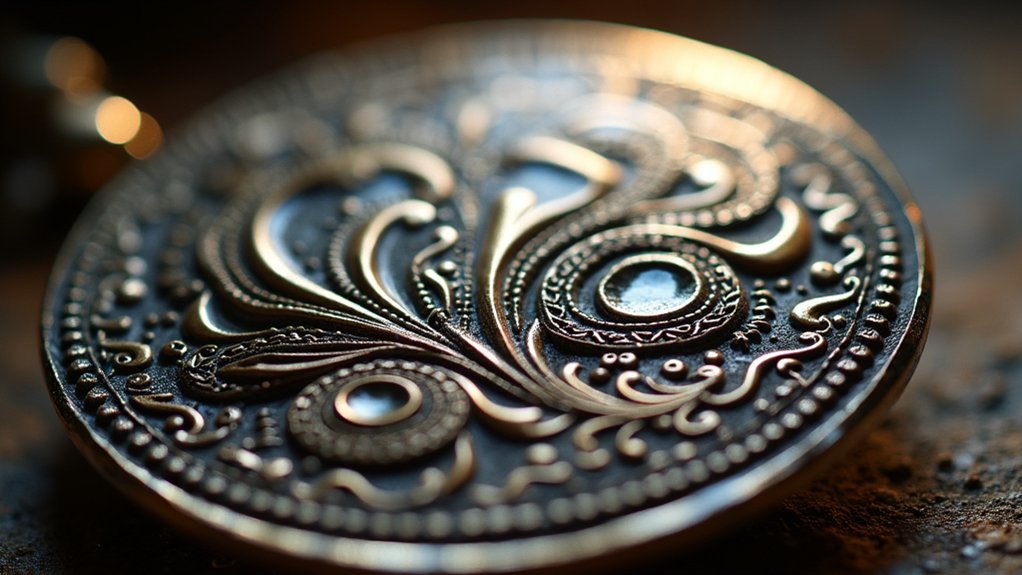
While modern jewelry making often relies on casting and machining, repoussé and chasing offer you a direct, hands-on connection to metalworking traditions that stretch back to 3000 B.C.
These complementary techniques transform flat metal sheets into dimensional artworks through strategic hammering. When you practice repousse art, you’re pushing metal from behind to create raised designs that emerge from the surface.
Chasing works as the perfect partner technique—you’ll outline and refine those raised areas from the front, pushing metal back down to create definition and contrast.
Together, these ancient methods give you complete control over texture, depth, and form. You’re not just making jewelry; you’re participating in humanity’s oldest metalworking traditions while developing tactile skills that machines simply can’t replicate.
Historical Significance and Cultural Heritage
Across continents and millennia, repoussé has left its mark on some of history’s most treasured artifacts. This technique that involves hammering metal from the reverse side has shaped cultural expression since 3000 B.C. You’ll find evidence of its mastery in Egyptian tombs, Greek temples, and Native American ceremonial pieces.
| Culture | Time Period | Notable Examples | Application |
|---|---|---|---|
| Egyptian | 3000+ B.C. | Tutankhamun mask | Royal artifacts |
| Greek | Classical era | Temple decorations | Religious items |
| Native American | Various periods | Ceremonial pieces | Cultural objects |
| Modern | Contemporary | Jewelry revival | Artistic expression |
The evolution of repoussé reflects humanity’s desire to transform simple metal into meaningful art. You’re witnessing a craft that’s bridged ancient civilizations with today’s artisans, creating both functional objects and decorative masterpieces.
Essential Tools and Material Knowledge
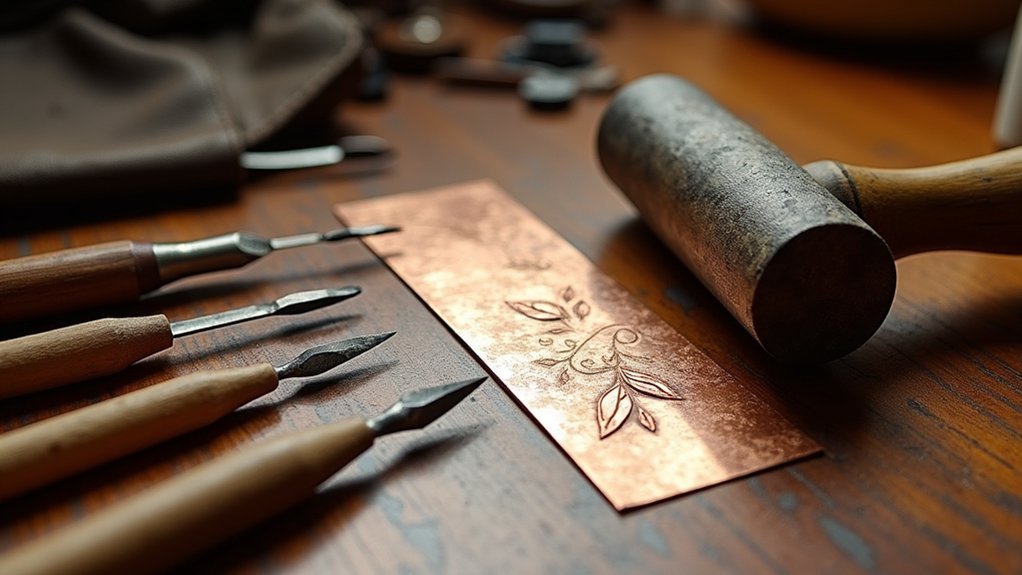
Understanding this rich heritage becomes meaningful when you pick up the tools that make repoussé possible.
You’ll need specific equipment to transform flat metal into dimensional art.
Your essential toolkit includes:
- Chasing hammer and chasing tools – various punches with liner, rounded, flat-faced, and doming shapes for creating intricate details
- Pitch bowl or cushion – specialized resin-based red pitch that holds metal stable and absorbs hammer blows
- Soft metals – copper (ideal for beginners), silver, or gold that respond well to hammering techniques
- Safety equipment – goggles and apron to protect against sharp edges and flying debris
Chasing tools can be custom-made or purchased, giving you flexibility in design creation.
Copper’s workability makes it perfect for learning, while the pitch bowl guarantees your metal stays positioned during the hammering process.
Proper Safety Practices and Workshop Protocols
Before you begin hammering metal into sculptural forms, establishing a safe workshop environment protects both you and your artwork.
You’ll need proper ventilation when working with pitch to avoid inhaling harmful fumes that can damage your health. Always wear safety goggles and an apron during the hammering process to shield yourself from flying debris and hot materials.
Maintain a clean, organized workspace to prevent accidents and boost your efficiency.
Regular tool maintenance is essential—check for sharp edges or damage that could compromise your safety. Use a sturdy work surface and secure your metal sheets in pitch or alternative supports. This prevents dangerous slipping during hammering and reduces injury risk while you create your repoussé pieces.
Hand-Eye Coordination and Fine Motor Skills Development
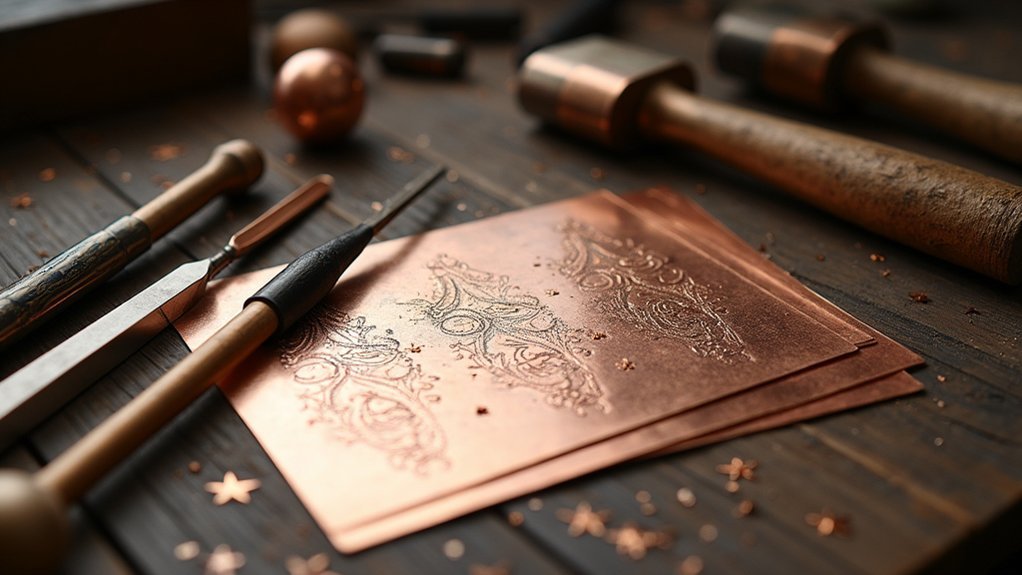
As you guide your hammer across the metal’s surface, repoussé jewelry making becomes a powerful training ground for hand-eye coordination and fine motor control.
You’re constantly transferring designs from paper to metal, strengthening the crucial connection between what you see and how your hands respond.
The demanding nature of this craft develops multiple physical skills:
- Precise tool control – You’ll master various punches and hammers while preventing metal damage
- Enhanced finger strength – Repeated manipulation of tools improves your grip and dexterity
- Rhythmic timing – Consistent hammer strikes require focused coordination and steady rhythm
- Spatial awareness – Pushing and shaping metal teaches you to visualize transformations before they happen
Through practice, you’ll notice improved fine motor skills that extend beyond jewelry making into everyday activities requiring delicate hand movements.
Patience and Methodical Approach to Craftsmanship
You’ll discover that repoussé jewelry making transforms your approach to craftsmanship through its inherently slow and deliberate process.
Each hammer strike must be calculated and purposeful, teaching you that rushing leads to mistakes that can compromise your entire piece.
Through countless repetitions of annealing, hammering, and refining, you’ll develop the precision that only comes from embracing methodical, patient work.
Slow Deliberate Progress
While machine production emphasizes speed and uniformity, repoussé jewelry making demands the opposite approach—each hammer strike must be deliberate and controlled to gradually coax your design from flat metal into dimensional art.
This slow, deliberate progression teaches you that rushing compromises both technique and outcome. You’ll discover that meaningful craftsmanship emerges through patient, methodical work rather than hurried attempts to reach completion.
The technique reinforces valuable lessons about sustainable creative practices:
- Temperature management requires careful timing between annealing cycles and pitch preparation
- Controlled strikes prevent metal damage while building volume gradually
- Embracing imperfections transforms mistakes into unique artistic characteristics
- Repetitive refinement develops focus and deeper appreciation for handcrafted quality
Each piece becomes a reflection of time invested and patience practiced.
Precision Through Repetition
Through countless controlled hammer strikes, repoussé transforms flat metal into sculptural jewelry while simultaneously training your hands and mind to work in perfect harmony.
Each methodical strike develops your muscle memory, creating the foundation for greater control and finesse in your hammering techniques. You’ll discover that precision emerges naturally through repetition—every accurately placed punch contributes to achieving the desired form and texture.
The discipline required for regular annealing teaches you to manage material properties through controlled heating and cooling, enhancing workability.
As you refine your techniques through persistent practice, you’ll learn to balance consistency with artistic expression. Embracing imperfections becomes part of your creative process, reinforcing patience’s value in achieving intricate designs that showcase true craftsmanship.
Problem-Solving Through Metal Manipulation
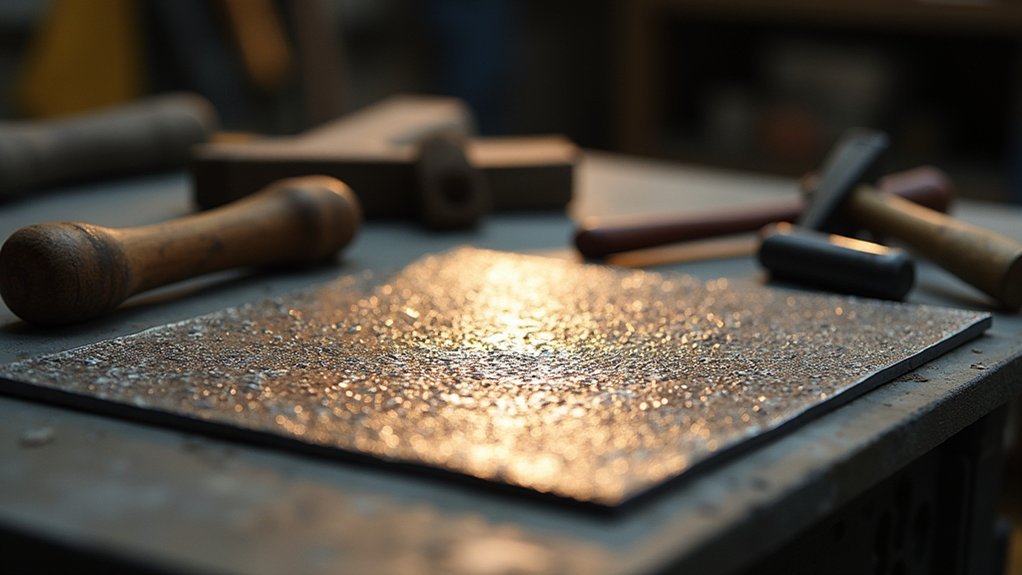
As you work metal into intricate jewelry forms, repoussé naturally becomes a masterclass in creative problem-solving. You’ll constantly adapt your approach when unexpected challenges arise, from varying metal hardness to distortions during hammering.
Critical thinking becomes essential as you learn to:
- Determine ideal annealing times to soften metal for successful manipulation
- Assess and adjust pitch temperature and hardness for design support
- Experiment with chasing techniques while managing medium constraints
- Develop iterative refinement processes for correcting imperfections
Through these hands-on experiences, you’ll develop practical materials science understanding in metalworking. Each piece you create teaches resilience and adaptability as you devise solutions for achieving intricate designs.
Every repoussé project becomes a masterclass in materials science, building resilience through creative problem-solving and adaptive craftsmanship.
The combination of technical knowledge and creative experimentation makes repoussé an invaluable problem-solving discipline, preparing you to overcome obstacles in both artistic pursuits and craftsmanship endeavors.
Design Planning and Spatial Visualization
You’ll need to master three-dimensional mental mapping to visualize how your repoussé design will appear from every angle before you begin hammering.
Understanding positive-negative space relationships becomes essential as you plan which areas to raise and which to leave recessed, creating the visual contrast that makes your jewelry compelling.
Pattern transfer techniques then bridge the gap between your mental vision and the actual metal surface, ensuring your spatial planning translates accurately to the physical piece.
Three-Dimensional Mental Mapping
Mastery of repoussé jewelry making demands that you develop sophisticated three-dimensional mental mapping skills before your hammer ever touches metal.
You’ll need to visualize how flat designs transform into raised sculptural forms, mentally rotating and manipulating shapes to predict their final appearance.
This mental mapping process strengthens through several key practices:
- Flipping metal repeatedly to work both sides creates extensive spatial understanding
- Transferring two-dimensional sketches onto three-dimensional surfaces builds depth perception
- Anticipating metal behavior under pressure develops material intuition
- Cycling through planning, execution, and refinement sharpens problem-solving abilities
Each strike of your hammer reinforces this mental map, teaching you to see beyond surface appearances.
You’ll develop an intuitive grasp of how shapes interact in space, making complex sculptural jewelry designs achievable through disciplined spatial thinking.
Positive-Negative Space Relationships
Building on your developing spatial awareness, positive and negative space relationships form the visual foundation of compelling repoussé jewelry designs.
You’ll discover how raised elements interact with surrounding flat areas, creating visual balance that captivates viewers. As you hammer metal, you must anticipate how each strike affects the relationship between your design and its background.
This spatial visualization skill becomes essential during design planning.
You’ll learn to create intricate patterns while maintaining clarity from multiple viewing angles. The contrast between raised and recessed areas directly impacts your piece’s visual depth and dimension.
Through exploring positive-negative space relationships, you’ll develop unique designs that engage viewers both visually and tactilely, transforming simple metal sheets into dynamic artistic expressions.
Pattern Transfer Techniques
Before you can begin shaping metal, successful pattern transfer requires precise planning that bridges your artistic vision with physical reality.
You’ll first draw your desired pattern on paper, then carefully mark the same design onto your metal surface using a pencil or fine marker pen.
To master this vital step, consider these essential techniques:
- Use a light source or tracing box to enhance visibility when aligning patterns on metal
- Break complex designs into simpler shapes for better spatial understanding during execution
- Practice repeatedly on different metal sheets to improve your spatial awareness
- Visualize your final piece in three dimensions before transferring
Pattern transfer techniques can be used effectively when you make deliberate choices about design placement and scaling for best repoussé results.
Understanding Metal Properties and Annealing
When you’re working with repoussé techniques, understanding your metal’s fundamental properties becomes the foundation for creating successful jewelry pieces. Malleability and ductility determine how your metal sheet responds to hammering and shaping without cracking. You’ll need to master annealing—heating metal to specific temperatures that soften it for easier manipulation.
| Metal Type | Annealing Temperature | Emotional Connection | Working Feel |
|---|---|---|---|
| Copper | 1,650°F (900°C) | Warm, earthy comfort | Forgiving, responsive |
| Silver | 1,200°F (649°C) | Precious elegance | Smooth, refined |
| Gold | 1,400°F (760°C) | Timeless luxury | Rich, substantial |
| Brass | 1,500°F (816°C) | Vintage charm | Sturdy, reliable |
You’ll repeatedly anneal throughout your process, maintaining workability after extensive shaping. This vital step prevents warping while enhancing your final piece’s surface quality and intricate details.
Precision and Control in Hammer Techniques
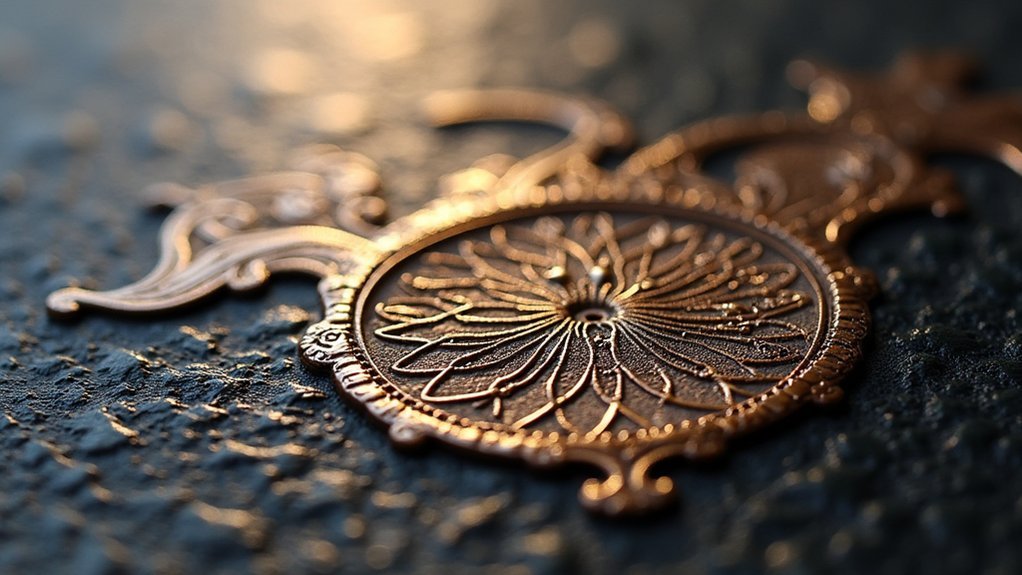
You’ll master repoussé jewelry making by developing controlled strike patterns that create consistent, deliberate impressions in your metal.
Your hammer’s weight and angle must work together as you maintain steady pressure through each strike, allowing you to build intricate designs with confidence.
Tool pressure mastery comes from understanding how different force levels affect your metal’s response, enabling you to create everything from bold outlines to subtle textural details.
Controlled Strike Patterns
Everything in repoussé jewelry making hinges on your ability to execute controlled strike patterns with precision and finesse. Each hammer blow must be deliberate, varying in force and angle to achieve the exact depth and detail your design demands.
You’ll discover that mastering these patterns transforms raw metal into intricate artistic expressions. Your success depends on these critical elements:
- Hammer technique mastery – Control angle and force with your chasing hammer for precise surface effects
- Strategic punch selection – Use liner and doming punches to create distinct textures and clean outlines
- Regular annealing – Maintain metal flexibility between strikes to prevent hardening
- Lightweight tool preference – Choose lightweight chasing hammers for delicate lines and intricate details
Through consistent practice, you’ll develop the finesse needed for controlled strike patterns that define exceptional repoussé jewelry.
Tool Pressure Mastery
Beyond mastering controlled strike patterns, your command of tool pressure becomes the defining factor that separates amateur work from professional-quality repoussé jewelry. You’ll discover that varying hammer weights creates precise lines and textures while maintaining a light grip enhances control and reduces fatigue.
| Tool Type | Pressure Level | Result |
|---|---|---|
| Rounded Punch | Light | Soft curves |
| Pointed Punch | Medium | Defined lines |
| Heavy Hammer | Controlled | Deep impressions |
Practicing with different chasing punches teaches you how tool pressure affects design depth and quality. Too much force distorts your metal, while insufficient pressure won’t achieve desired depth. You’ll need continuous refinement through practice to embrace the “give and take” nature of this technique, ultimately creating unique, tactile pieces.
Artistic Vision and Creative Expression
When you translate intricate designs from paper to metal through repoussé, you’re developing a unique artistic vision that bridges concept and creation. This ancient technique transforms your creative expression into tangible art through deliberate hammer strikes and metal manipulation.
Each piece becomes distinctly yours because:
Your personal touch emerges through every hammer strike, creating one-of-a-kind textures and authentic imperfections that define your artistic signature.
- Tactile textures emerge from your individual hammering style and tool pressure
- Dimensional boundaries expand when you combine chasing with repoussé techniques
- Imperfections become features that add authentic character to your work
- Material understanding deepens as you experiment with different metalworking approaches
You’ll discover that repoussé doesn’t just teach technical skills—it cultivates your ability to problem-solve creatively.
As you work through design challenges, you’re building confidence in your artistic instincts while learning that flaws can enhance rather than diminish your jewelry’s beauty.
Appreciation for Handmade Versus Machine-Made Objects
As you hammer each curve and chase every detail into metal, you’ll develop a profound respect for the deliberate imperfections that define handcrafted jewelry.
Through repoussé techniques, you’ll discover how these variations create character and authenticity that machine-made items can’t replicate. Each piece tells the story of your hands working metal, creating tactile qualities that mass production simply can’t achieve.
Your appreciation for handmade objects deepens as you experience the time and skill required for detailed designs.
You’ll understand the stark contrast between your careful, intentional work and industrial manufacturing’s speed. This hands-on experience connects you to each piece’s story and intention, fostering a meaningful relationship with handcrafted objects that transcends the superficial appeal of uniform, machine-made alternatives.
Building Confidence Through Mastering Traditional Skills
Through each deliberate hammer strike, you’ll build unshakeable confidence as ancient metalworking techniques become extensions of your creative vision.
Working with traditional tools and pitch trains your hands to execute precise movements while your mind develops problem-solving skills essential for metalworking mastery.
As you progress through each project, you’ll experience:
- Enhanced fine motor control – Manipulating punches and working against pitch develops exceptional hand-eye coordination
- Adaptive problem-solving abilities – Constantly evaluating and adjusting your approach builds creative flexibility
- Deep historical connection – Learning centuries-old techniques connects you to master craftspeople throughout history
- Tangible accomplishment – Transforming flat metal into dimensional art creates lasting pride in your abilities
Each completed piece reinforces your growing expertise, proving you can master skills that once seemed impossible.
Frequently Asked Questions
What Is the Repoussé Technique of Jewelry?
You’ll hammer metal from behind to create raised, three-dimensional designs in jewelry. You’re pushing the material outward using rounded punches, then refining details from the front through chasing techniques.
What Is the Difference Between Embossing and Repoussé?
You’ll find embossing presses designs from the front surface, while repoussé hammers metal from behind using pitch support. Repoussé creates deeper dimensionality and requires more skill than embossing’s straightforward surface-level approach.
How Does Repoussé Work?
You’ll hammer metal from behind on a pitch backing to create raised designs. You’ll need to anneal the metal first for flexibility, then repeatedly hammer and re-anneal while refining details through chasing.
What Is the Chasing and Repousse Technique?
You’ll hammer metal sheets from both sides, creating detailed outlines through chasing and three-dimensional forms through repoussé. You’re fundamentally sculpting metal by pushing and pulling it into artistic shapes and designs.
In Summary
You’re learning far more than metalworking when you practice repoussé jewelry making. You’re connecting with centuries of cultural tradition while developing precise motor skills and artistic vision. You’ll gain deep appreciation for handcrafted quality and build unshakeable confidence through mastering this demanding technique. Each hammer strike teaches patience, control, and creative problem-solving. You’re not just shaping metal—you’re shaping yourself into a more skilled, confident, and culturally aware artisan.

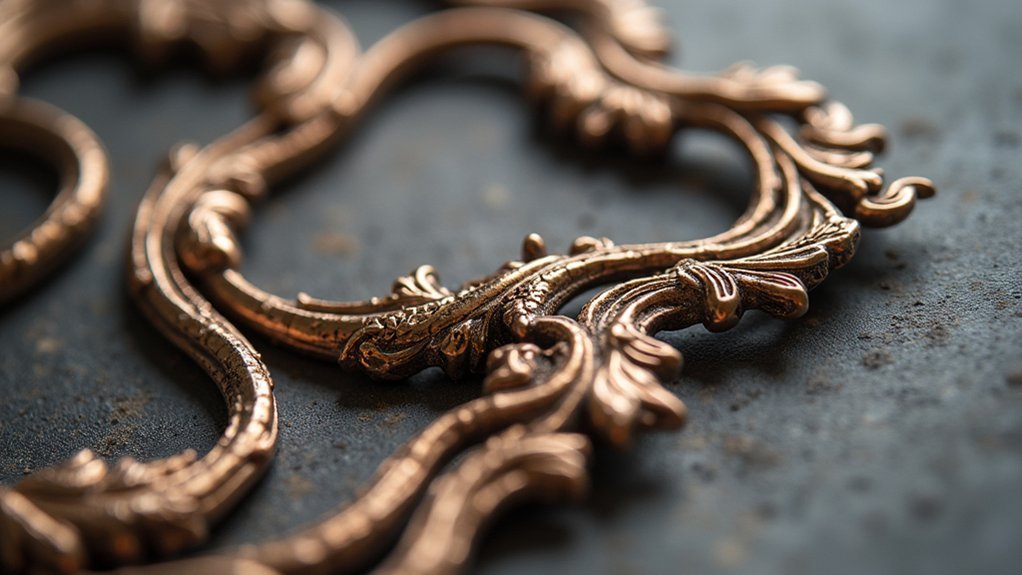



Leave a Reply